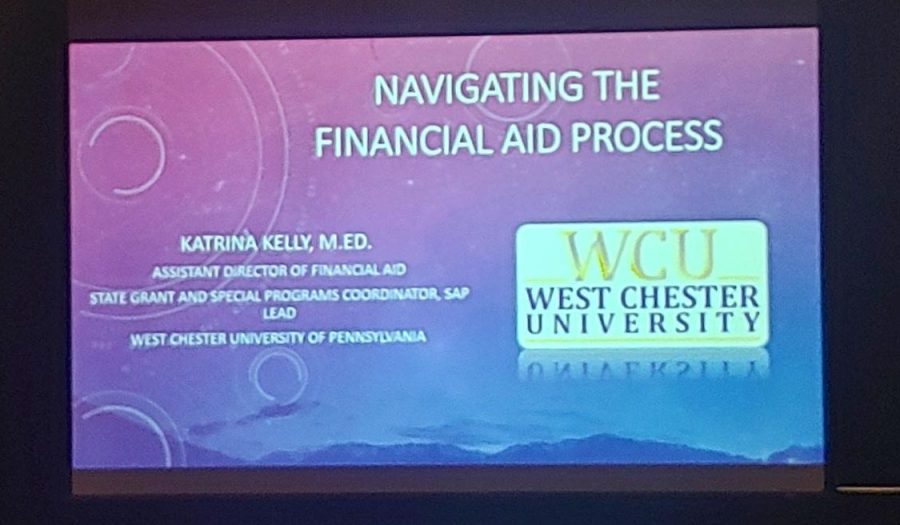Navigating FAFSA: Your Guide to Financial Aid
October 16, 2022
“Don’t be scared to talk about finances!” says West Chester’s assistant director of financial aid, Katrina Kelly during Methacton’s Financial Aid Night. Applying to colleges can be hard enough without having to worry about finances, but Kelly and her colleagues want you to know it is not as hard as you might think.
The FAFSA (Free Application for Federal Student Aid) opened on October 1st and can be filled out up to the end of the next summer. However, just because you have this large window does not mean you should wait until the last minute. “You have a better chance at “free” money the sooner you apply.” advises Kelly. If you are not sure how to approach starting the FAFSA, both she and Mrs. Hartson (Head of Methacton counseling department) recommend the following sites: studentaid.gov, getfafsahelp.org, and PHEAA.org. These sites plus extra helpful resources (like ones that were handed out during Methacton’s financial aid night) are now posted on Methacton’s virtual bulletin board.
Now let’s get into the specifics about filling out your FAFSA. One important thing to note before you start is that the FAFSA is 100% free to fill out. If the website you are on asks you to pay, you are in the wrong place.
The first thing you need to do is set up your FSA ID; both you and at least one parent/guardian must create one. To register for your FSA ID, visit fsaid.ed.gov and create a new account using an email address that you will always have (so NOT your school email!!)
Now that you have made your ID you can now officially begin filling out your FAFSA. Go to studentaid.ed.gov (or you could even download the FAFSA app on your phone). From there the website breaks everything down into sections for you. First you will need to fill out the demographic section, mostly basic information about yourself. Next is when you select which schools you are thinking about applying to and any other special programs you would want to join so FAFSA can take that into consideration. Then there is your “dependency status,” and this will cover a variety of things. You will fall into one of two categories: Dependent or Independent.
Dependent is when you have your needs provided for by your parents (whether separated or together, or if you have one living parent). Note that if your parents are separated, you must figure out how you wish to fill out the FAFSA, meaning which parent will provide more for you and will fill out upcoming sections on the FAFSA. If you are unsure of how to approach this check out one of the sites mentioned above.
Independent is for students with special cases. If you choose to file as an independent then you are required to provide information and proof that you are any of the following: both parents were deceased before the age of 13, you have legal guardianship over someone (or provide for someone that takes over 50% of your income), or if you are homeless or have ever been homeless. These factors will affect the amount of money you can be granted in aid.
This next part is where you may need a parent or guardian to help you. You must now provide FAFSA with financial information, more specifically your “prior-prior year” tax information. To lay it out, 12th graders will be completing the “2023-2024” FAFSA with 2021 tax information, 11th graders 2022 taxes, 10th graders 2023 taxes, and 9th graders 2024 taxes (yes even underclassmen can start looking into financial aid). Now this will be a lot of information to manually enter, but lucky for you, Katrina Kelly shares this important information: “Data retrieval tools are linked within this section of the FAFSA”. So all you and your parent have to do is enter in your basic information into this tool exactly the way it is seen on your taxes and ta-da, all of your data gets transferred.
Congratulations! You have now successfully finished your FAFSA. Now all you need to do is apply to your colleges and wait. Be patient though, after filling out the FAFSA the Board of Education will determine how much they can give you and how much you will be predicted to pay. Now do not be worried if the amount FAFSA says you are “expected” to pay is too high for you and your family. This is only a rough estimate. You will be able to work with colleges that have accepted you and plan out a more personalized plan. Katrina Kelly recommends that once you start getting accepted to schools, compare them and see what is the best financial option for you. “Take your time and read each plan carefully,” says Kelly.
Extra Tips
If you are thinking about staying local, don’t be afraid to fill out the PHEAA. The PHEAA is basically Pennsylvania government grants, in other words “free” money! “Even if you don’t think you will get anything, still fill it out” advises Kelly. And she’s right, why not take a shot at some extra money. The PHEAA will be linked right when you finish the main FAFSA. All you do is put in your basic information and you’re done. Yes, it’s that simple!
Speaking of free money, don’t discount scholarships. “Apply, apply, apply!” says Mrs. Hartson. It can never hurt to branch out and apply to as many scholarships as you can. Many great ones are linked on the Methacton virtual bulletin board, and can also be found outside the counseling office. When doing these scholarships do not overlook the small ones, those $50-100 stack up. Any little bit helps!
Lastly, if you still feel unsure about this whole process, or you just need some extra help check out Methacton’s FAFSA completion night on November 3rd! To have your parents sign up go to the Methacton Highschool website, go to the calendar, click November 3rd, and it will take you right to the sign up. Sign up soon as spots fill up fast!
Good luck on your financial aid journey. Remember there will always be resources to help you, so don’t stress. If you have any more questions, reach out to a financial aid director or your counselor.



